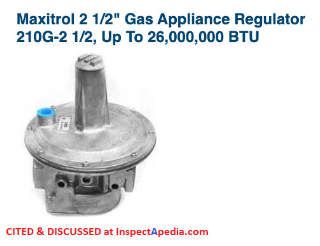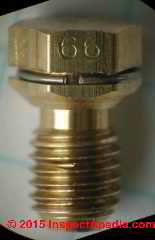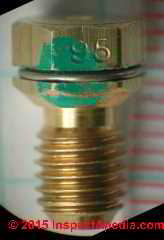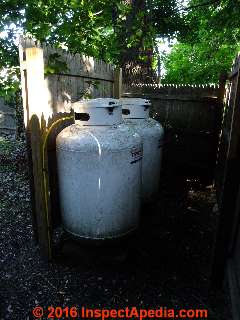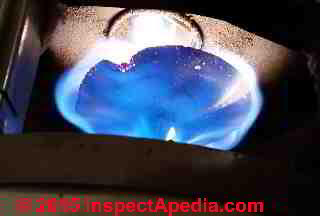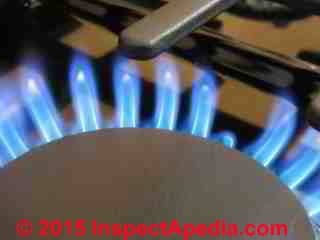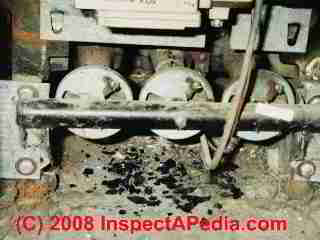 Gas Burner Sooting Diagnosis & Repair
Gas Burner Sooting Diagnosis & Repair
Weak or Sooty Gas Appliance or Gas Heater Flame
- POST a QUESTION or COMMENT about gas burner operating problems: flame sooting defects, noises, safety hazards
What are the causes of soot at gas burners? Is soot at the gas burner dangerous?
This article series provides descriptions and photographs of unsafe gas piping, indications of unsafe or improperly operating gas appliances, gas meters, and other gas installation defects are provided.
InspectAPedia tolerates no conflicts of interest. We have no relationship with advertisers, products, or services discussed at this website.
- Daniel Friedman, Publisher/Editor/Author - See WHO ARE WE?
Weak Yellow or Sooty Gas Flame Cause & Cure
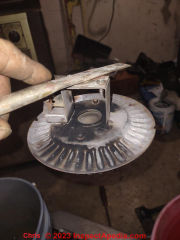 Watch out: soot observed on or around an LP or or natural gas burner can be a sign of extreme danger.
Watch out: soot observed on or around an LP or or natural gas burner can be a sign of extreme danger.
Photo of a sooty LP gas water heater, courtesy of InspectApedia reader Chris B.
[Click to enlarge any image]
Normally, gas fired appliances run rather clean and with no soot deposition.
But if there is a combustion air problem, a system can soot up and even completely clog a flue with soot very quickly - in minutes or hours.
The risk is potentially fatal carbon monoxide poisoning of building occupants.
Four Most Common Causes of Soot at a Gas Burner
When we see sooting at the burner of an LP gas stove or water heater, we have the following possible causes to check:
- Inadequate combustion air:
either appliances are in a too small enclosed space or the appliance air shutter/control is not properly adjusted - Improper LP gas supply pressure:
perhaps an improperly-set primary regulator at the tank OR gas supply piping is too small and its run distance too long - Wrong gas metering orifices:
in the LP or natural gas appliance - Bad fuel supply:
the LP gas itself that is delivered to the building could be bad, improperly mixed or stored
Diagnostic Steps: causes of gas burner sooting
Watch out: sooting at any gas burner means combustion is improper: in this condition the sooting appliance(s) can produce dangerous, even fatal carbon monoxide gas - be sure you have working CO detectors in your home, properly installed, located, tested.
Inadequate combustion air flow
IF the sooting problem were at just one appliance, I'd suspect improper air shutter adjustment at the burner control on a gas range or stove, or improper air shutter adjustment on the air mixture tube on the gas burner of a gas furnace, boiler, or water heater.
But when sooting is appearing on the burners of all appliances, the problem is probably one of the other sooting gas appliance causes described here.
Also see GAS FLAME COLOR CHECK for more examples of gas flame color checks and the relationship between air mix and gas flame.
Improper LP gas supply pressure
If the problem is at all appliances and has always been present, since installation, it's possible that the gas delivery rate is too weak - low gas pressure.
Three common causes of poor gas pressure at appliances are
- Primary regulator is set improperly
See GAS REGULATORS & APPLIANCE / HEATER CONTROLS
Also see GAS REGULATOR NOISES - problems with gas-air mixture can cause noise at the appliance regulator as well as defective gas flame or too low gas flame. - Gas piping diameter size is too long for the distance of the piping run -
See GAS PIPING SIZE & MATERIAL - Low LP gas fuel level - almost out
It's also possible to see low gas pressure when the LP tank is nearly out of fuel.
Check the fuel level gauge at your LP gas tank.
Wrong gas orifices at the gas appliance
If the gas metering orifices at the appliance are the wrong ones - for example, if an appliance was delivered/installed set-up for natural gas, you'd need to change the orifices at each burner to use LP propane gas.
We might suspect this cause if some appliances work fine and others never have, or if you bought appliances set up for natural gas and are using propane (or vice versa).
See details at CONVERT the GAS ORIFICES
Delivery of bad LP gas
The delivery of LP gas itself could have been bad. If you were not seeing this problem until after a recent LP gas delivery, I suspect the gas itself was bad, improperly mixed or stored - call your gas delivery company for help.
Other less common but possible causes of sooting at gas burners
- Dirt or debris clogging gas outlet at a burner
If the sooting problem is occurring only at one gas burner, then check for spills or debris that may be blocking the gas orifice or the gas burner openings.
- Blocked chimney or flue
or other causes of bad draft such as an open chimney cleanout door or missing chimney rain cap
If sooting is occurring at the burner of a gas heater or water heater vented into a chimney, check for a chimney draft problem or a blocked flue.
Examples of Improper Gas Burner Flame
The photo offers a view of a damaged gas burner flame dispersing cone and also of the passage of gas combustion products up through the center flue of this calorifier. The flame colours are normal, mostly blue with yellow tips.
Our gas flame colour illustration shown above, adapted from Bosch (2014), shows how you might distinguish among the properties of the following:
- Unhealthy, mostly yellow gas burner flames (top, check the gas regulator and air mix) that can occur on either LP (or propane) or natural gas burners.
- Healthy yellow tips on outer cones of otherwise blue flames (center) is characteristic
What the Bosch drawing and our photos above do not show are other gas burner flame defects such as noises, flame lifting off of the burner, flame jumping excessively, flame uneven, or blocked at some orifices by debris or spills or lastly and particularly dangerous, the presence of soot - an indication of a serious even fatal carbon monoxide hazard.
Above we see a normal LP gas flame at the burner of a gas stove installed in Poughkeepsie, NY.
Watch out: Any of these LP gas, propane, or natural gas burner conditions is potentially very dangerous and needs prompt attention. You should have your utility company or service person check the appliance immediately.
Immediate LP or natural gas safety hazards: if there is evidence of an LP or natural gas leak at a building, gas odors, for example, you should:
- Do not do anything that is likely to cause a gas explosion, such as lighting a match, operating an electrical switch, or even using a telephone in the building
- Leave the building immediately
- Notify other building occupants of the safety concern
- Contact the local gas company and/or fire department
Watch out: General safety warning: improper installation and even improper inspection and testing methods involving natural or "LP" gas can involve dangerous conditions and risk fire or explosion.
If you smell gas, you should leave the building immediately and should do so without doing anything that could create a spark such as operating a light switch or telephone. From a safe location, call your gas company's emergency line and/or your fire department.
...
Reader Comments, Questions & Answers About The Article Above
Below you will find questions and answers previously posted on this page at its page bottom reader comment box.
Reader Q&A - also see RECOMMENDED ARTICLES & FAQs
2023/03/27 (mod) - causes of soot at gas burners
Thanks for a helpful question. We put together a comprehensive list of causes of sooting at the burners of any gas appliance, such as a gas range or water heater or boiler/furnace heater, now found above on this page where we include your photo as well.
Please step through those diagnostic suggestions and let me know what you find. Your feedback will help other readers.
2023/03/27 Chris B - why do my LP appliances keep sooting up?
Why do my LP gas appliances keep sooting up?
This is the burner from my hot water heater. Also the pilot light flame seams very orange. On my gas range the flames grow and shrink randomly and have little white tips. Any suggestions
...
Continue reading at GAS BURNER FLAME & NOISE DEFECTS or select a topic from the closely-related articles below, or see the complete ARTICLE INDEX.
Or see these
Recommended Articles
- BLUE vs YELLOW COMBUSTION FLAMES
- COMBUSTION AIR DEFECT EFFECTS
- COMBUSTION AIR REQUIREMENTS
- CONVERT the GAS ORIFICES - change between LP Propane & Natural Gas; changes for high altitude gas appliance or heater operation
- GAS APPLIANCE CONVERT LP-to-NATURAL GAS
- GAS BURNER FLAME & NOISE DEFECTS
- GAS BURNER SOOT CAUSE & CURE
- GAS REGULATORS & APPLIANCE / HEATER CONTROLS - also need adjustment for tall buildings or high altitude
- GAS IGNITER DIAGNOSIS & REPAIR
- GAS PIPING SIZE & MATERIAL
- GAS PRESSURES LP vs NATURAL GAS
- GAS REGULATORS & APPLIANCE / HEATER CONTROLS
- SOOT on OIL FIRED HEATING EQUIPMENT
Suggested citation for this web page
GAS BURNER SOOT CAUSE & CURE at InspectApedia.com - online encyclopedia of building & environmental inspection, testing, diagnosis, repair, & problem prevention advice.
Or see this
INDEX to RELATED ARTICLES: ARTICLE INDEX to GAS APPLIANCES, PIPING, CONTROLS
Or use the SEARCH BOX found below to Ask a Question or Search InspectApedia
Ask a Question or Search InspectApedia
Questions & answers or comments about gas burner operating problems: flame defects, noises, safety hazards.
Try the search box just below, or if you prefer, post a question or comment in the Comments box below and we will respond promptly.
Search the InspectApedia website
Note: appearance of your Comment below may be delayed: if your comment contains an image, photograph, web link, or text that looks to the software as if it might be a web link, your posting will appear after it has been approved by a moderator. Apologies for the delay.
Only one image can be added per comment but you can post as many comments, and therefore images, as you like.
You will not receive a notification when a response to your question has been posted.
Please bookmark this page to make it easy for you to check back for our response.
IF above you see "Comment Form is loading comments..." then COMMENT BOX - countable.ca / bawkbox.com IS NOT WORKING.
In any case you are welcome to send an email directly to us at InspectApedia.com at editor@inspectApedia.com
We'll reply to you directly. Please help us help you by noting, in your email, the URL of the InspectApedia page where you wanted to comment.
Citations & References
In addition to any citations in the article above, a full list is available on request.
- Bosch, "LP Gas Conversion Kit Installation Manual , NGM Gas Cooktops (NGM30, NGM50, NGM 56, NGM80, NGM86, NGMP65)", (2014), Bosch, 1901 Main St., Suite 600, Irvine CA 92614, Tel: 800-944-2904, Website: www.bosch-home.com
- In addition to citations & references found in this article, see the research citations given at the end of the related articles found at our suggested
CONTINUE READING or RECOMMENDED ARTICLES.
- Carson, Dunlop & Associates Ltd., 120 Carlton Street Suite 407, Toronto ON M5A 4K2. Tel: (416) 964-9415 1-800-268-7070 Email: info@carsondunlop.com. Alan Carson is a past president of ASHI, the American Society of Home Inspectors.
Thanks to Alan Carson and Bob Dunlop, for permission for InspectAPedia to use text excerpts from The HOME REFERENCE BOOK - the Encyclopedia of Homes and to use illustrations from The ILLUSTRATED HOME .
Carson Dunlop Associates provides extensive home inspection education and report writing material. In gratitude we provide links to tsome Carson Dunlop Associates products and services.


